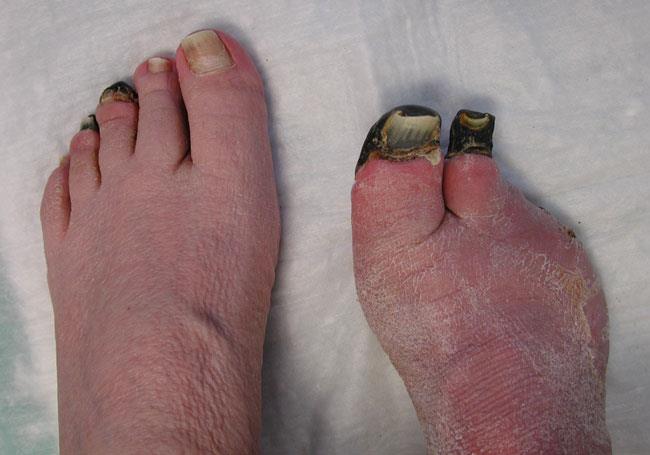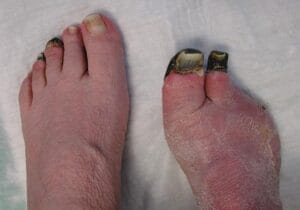Frostbite occurs when the body’s tissues are damaged due to exposure to extreme cold. The areas most often affected include the nose, cheeks, ears, fingers, and toes, as these extremities are more vulnerable. This condition can lead to numbness, discoloration, and in severe cases, permanent tissue damage, potentially resulting in the need for amputation.
To prevent frostbite during winter, it’s essential to protect exposed skin while engaging in outdoor activities, participating in winter sports, or even running errands. The risk is highest in extremely cold temperatures, but frostbite can also develop in above-freezing temperatures if strong winds are present.
Rephrased Paragraphs:
Description
When exposed to cold weather, your body prioritizes maintaining its core temperature. To achieve this, it redirects blood from the extremities, like the hands and feet, to the central organs such as the heart and lungs, where it is needed most. While this protective response ensures vital organ function, it also heightens the risk of cold-related injury to the fingers, toes, and other outer body parts.
Frostbite occurs when body tissues actually freeze, forming ice crystals within the cells. This process causes physical damage and alters the cell’s chemistry, which can result in permanent harm. Upon thawing, further cellular changes may take place, potentially leading to cell death.
Frostbite can be classified into two levels of severity:
- Superficial frostbite: This type affects only the skin’s surface.
- Deep frostbite: This more severe form extends to the underlying tissues.
In this patient, deep frostbite caused permanent tissue damage and three toes on the right foot required amputation.
Causes
Frostbite is primarily caused by exposure to extremely cold temperatures. Vulnerable groups include the elderly and young children, who are at greater risk. Additional risk factors contributing to frostbite include:
- Wearing inadequate clothing for cold conditions, prolonged exposure to low temperatures, or getting wet while outdoors.
- Medical conditions that impair circulation, such as diabetes or atherosclerosis.
- A history of cold-related injuries.
- Use of certain substances like alcohol, nicotine, or medications, including beta-blockers, which can reduce blood flow to the skin.
Rephrased Paragraphs:
Symptoms
Recognizing the signs of frostbite early is crucial for seeking prompt medical attention if needed. Common symptoms include:
- Numbness in the affected area.
- A frozen feel in the skin, with deeper tissues remaining soft in cases of superficial frostbite, or a hard, solid feel if deep frostbite is present.
- Skin that appears waxy, white, or grayish in color.
Treatment
If frostbite is suspected, seek medical help immediately, as the condition can lead to severe complications. The restriction of blood flow and oxygen to the affected tissues can cause cell death, potentially resulting in permanent damage and the need for amputation. In some instances, frostbite may also be accompanied by hypothermia, a dangerous cold-related condition requiring emergency intervention.
If immediate medical care is unavailable, follow these guidelines for initial treatment:
The “DO’s”
- DO move the person indoors to a warm area as quickly as possible.
- DO call for medical help immediately. While waiting, offer the person warm drinks such as tea or broth.
- DO rest the injured areas and keep them elevated if needed.
- DO remove any wet or tight clothing.
- DO gently warm the frostbitten area by immersing it in warm (not hot) water for 30-45 minutes, or until warmth and sensation return. Be prepared for pain, swelling, or color changes during this process.
- DO prevent infection by leaving any blisters intact and covering them loosely with a sterile cloth.
The “DON’Ts”
- DON’T perform any actions that could worsen tissue damage.
- DON’T rub or massage the frostbitten area, whether with your hands, snow, or any other object.
- DON’T walk on frostbitten feet; keep the person seated with their feet elevated.
- DON’T rewarm the area if there is a risk of it becoming cold again, as refreezing can cause additional harm.
- DON’T use direct heat sources, such as heating pads, fires, hairdryers, or radiators, to warm the skin. The numbed area may burn easily.
Prevention
Preventing frostbite is far easier than treating it. If venturing out into cold weather, take these five precautions to reduce your risk:
- Dress in layers: Wear light, loose, layered clothing that provides both ventilation and insulation. Choose outer layers made of water-resistant, not waterproof, materials.
- Protect extremities: Wear a warm hat to prevent heat loss through the scalp, use mittens instead of gloves, and layer socks (wool over lightweight cotton) to keep your feet warm.
- Avoid alcohol and smoking: Refrain from consuming alcohol, caffeine, or nicotine before exposure to cold, as these substances make skin more susceptible to cold injury.
- Stay dry: If you get wet, change into dry clothes as soon as possible.
- Monitor for symptoms: Regularly check yourself for signs of frostbite, especially in the fingers, toes, nose, and ears. If numbness occurs, move indoors immediately.






